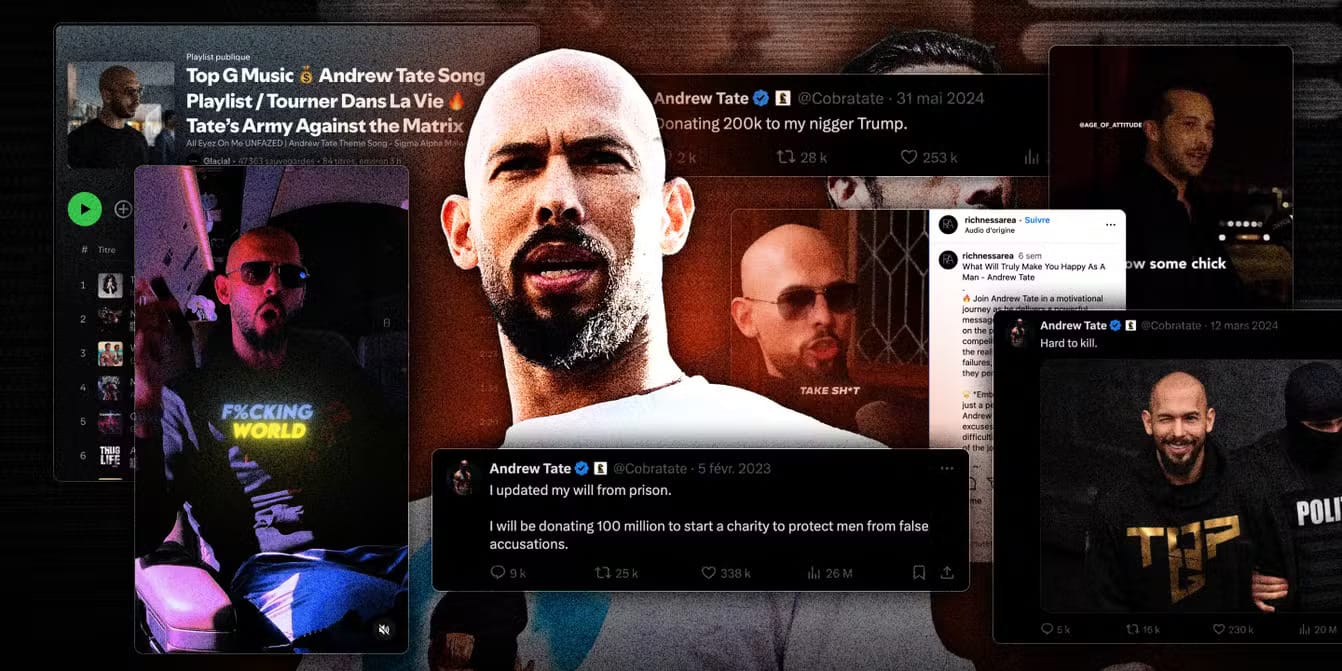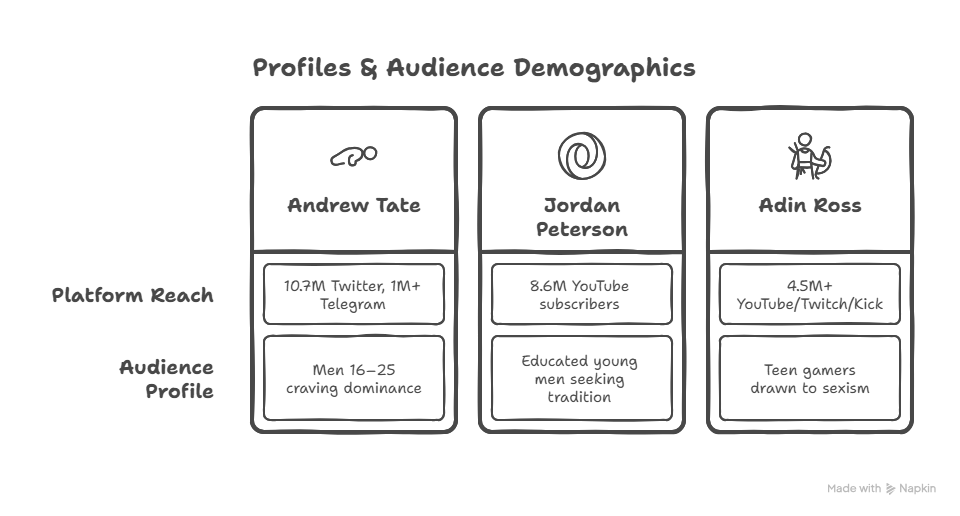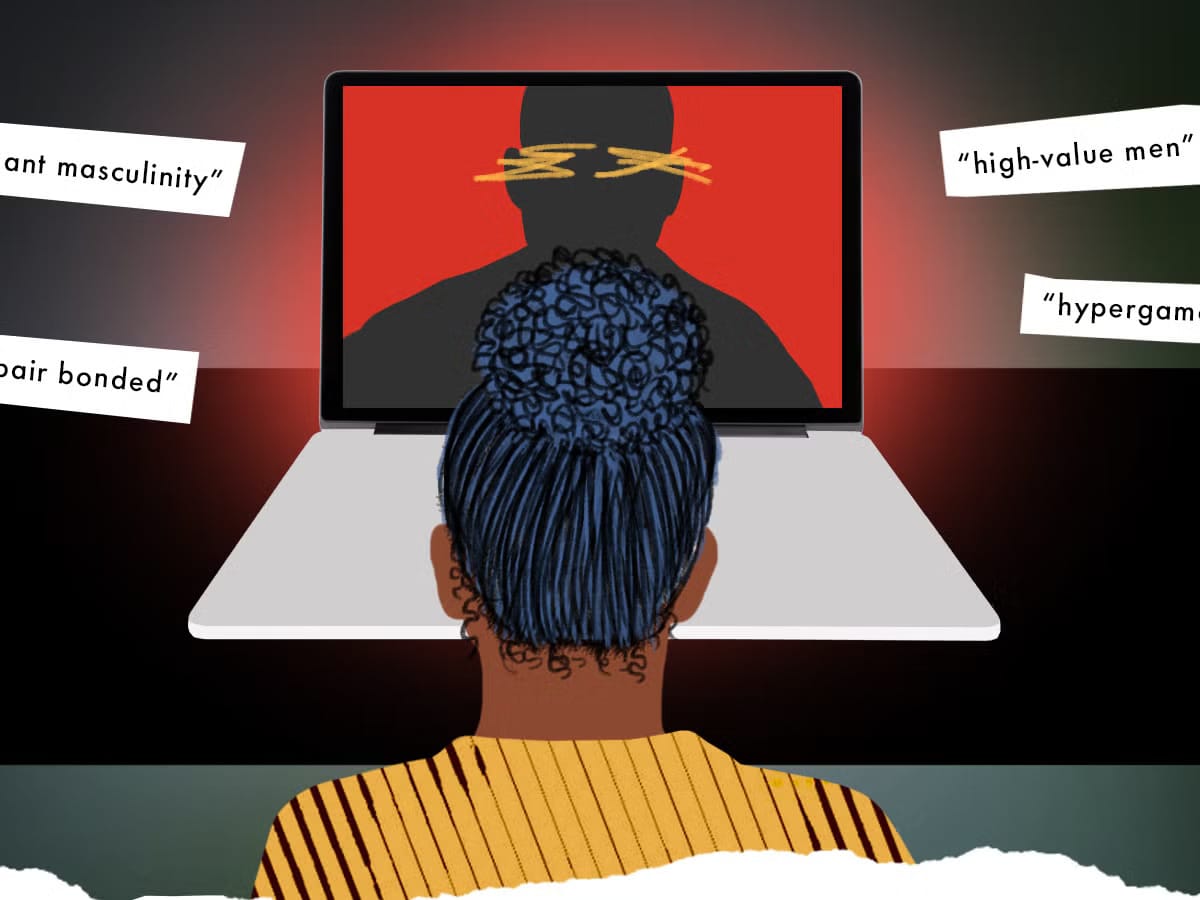Influencers or Instigators? The Dangerous Fame Game of Online Misogyny
How toxic influencers use self-help rhetoric, algorithmic virality, and platform escape routes to spread misogyny to Gen Z men.

LONDON, July 1, 2025
In today’s digital world, including TikTok, Rumble, and Telegram, more male influencers are redefining masculinity as a harsh status competition. They claim to offer self-improvement, confidence, and camaraderie, but instead promote toxicity, misogyny, and outrage. For young men in Gen Z, this isn’t just a form of satire or a quirky community. It’s indoctrination. Known as the manosphere, this online network has shifted from niche forums to mainstream influencer culture, and it is changing young male identities in harmful ways.
From Fringe Forums to Viral Influence
Terms like Red Pill, MGTOW, incel, and pickup-artist used to exist in obscure parts of the internet. That has changed.
The rise of polished influencers: Figures like Jordan Peterson and Andrew Tate, often called “hustle-bros,” mix motivational content with anti-woman messages.
Platform migration: After major platforms imposed bans, these voices moved to Telegram, Rumble, and email lists, while some still gained views on YouTube through reuploads.
Algorithmic reinforcement: Research from ISD and ISD Global shows that recommendation systems, especially on YouTube Shorts, often push young men toward more misogynistic content.
Key influencers
- Andrew Tate: With 10.7 million Twitter followers, he is seen as the “king of toxic masculinity.” Despite a YouTube ban, his Telegram has over 1 million supporters.
- Jordan Peterson: A clinical psychologist with 8.6 million YouTube subscribers, he has popularized conservative gender ideals.
- Adin Ross: A gaming streamer who mixes misogynistic comments with gameplay, attracting millions.

Masquerading Mentorship: Emotional Hooks and Recruitment
What attracts young men to this content?
Emotional vulnerability: Gen Z boys increasingly report feelings of loneliness, bullying, and lack of father figures, creating a longing for community. A recent study found that many participants felt less alone after engaging with manosphere content.
Trojan-horse messaging: Influencers disguise harsh gender ideas within messages about wellness—fitness, personal growth, and financial success—making it seem like helpful advice rather than sexism.
Normalization of aggression: Users and researchers highlight how these discussions often lead to harassment, body-shaming, and slut-shaming. A paper from spring 2022 even links manosphere communities to signs of radicalization.
Real wounds, false cures: Discussions about mental health, like “crashing out,” are manipulated to promote old-fashioned ideas of masculinity, suggesting that healing involves taking back control or blaming women.
Toxicity as a Brand: Outrage, Profit, and Platform Evasion
Manosphere creators make money through fear, hate, and spectacle.
- Ad revenue and reuploads: Misogynistic content from the Tate era profits from YouTube ads and reuploaded videos aimed at teens as young as 13.
- Affiliate mystique: Offers like “escape the matrix,” gyms, courses, and Hustler’s University mix self-help language with sexist ideas.
- Cross-platform funnels: YouTube bans push creators to Telegram groups, Rumble channels, Discord servers, and mailing lists—helping retain audiences even off mainstream platforms.
- Algorithmic amplification: Research from ISD Global shows that recommendation systems actively direct young users to radical content.
Imran Ahmed (CEO, Center for Countering Digital Hate) said, “Social media platforms are not bystanders; they are complicit in the radicalization of young men.”
Gen Z Humor and the Masking of Misogyny
One main reason this content thrives is that it often presents itself as edgy humor or meme culture.
Sigma grindset and gym bro memes: These combine fitness motivation with sarcastic gender slurs, normalizing toxicity as humor.
“Crashing out” aesthetic: Dark humor around emotional breakdowns presents vulnerability in a way that seems to uplift, while actually depressing.
Mockery-based disguise: “Just joking” sexism softens critiques and avoids moderation, while embedding unspoken biases.

Mental Health as a Trojan Horse
Influencers feign concern while rewriting recovery.
Looksmaxxing (body-improvement) often turns into messages focused on body-shame, suggesting only “good” men are fit and dominant.
Suicide-romanticization: Extended discussions about sadness are framed as masculine suffering, discouraging genuine therapy.
Fake healing communities: Telegram support groups often become echo chambers of misogyny disguised as recovery.
The Banned but Not Broken: Platform Evasion Tactics
Even bans can’t stop their advancement.
Tate’s multi-platform resilience: YouTube videos are mirrored on Telegram; Rumble hosts full talks; email funnels and subscription services provide a steady income.
Misogyny hybridized: While less direct on mainstream platforms, creators mix lifestyle tips with hidden sexist tones.

Ethical & Legal Crossroads
Platform accountability vs. free speech
- UK Ofcom’s new guidance requires platforms to treat misogyny as harmful content, emphasizing safety and prompt warnings.
- Australia is thinking about bringing YouTube under its regulations for users under 16 after research revealed that teens access Tate’s misogynistic videos.
- A leaked UK counter-extremism report identified the manosphere as a space ripe for radicalization and called for measures to disrupt harmful behaviors.
Free speech concerns
- Critics say targeting misogynistic content risks censorship and often overlooks the practicality of enforcement.
- Supporters claim that inaction from platforms effectively allows digital hate to continue, especially paired with powerful algorithms.
Seyi Akiwowo (Founder, Glitch Digital Rights Org) emphasized, “Online spaces are not safe for women—and the manosphere is fuelling that hostility.”
What Happens Next?
Platform enforcement: Tech companies need to close loopholes, like reuploads on YouTube and Shorts amplification, and apply bans on misogyny consistently, especially for younger audiences.
Digital literacy initiatives: Schools and youth nonprofits should teach critical viewing skills. This can help teens understand the difference between real self-help and ideological manipulation.
Mental health safeguards: Support networks must provide accessible, stigma-free therapy. Real healing does not need toxic masculinity as its foundation.
Regulatory evolution: Digital policy should classify targeted misogyny as extremist content that needs monitoring and removal, particularly for minors.
Research and watchdogs: More independent studies, like those from ISD, CCDH, and Ofcom, are needed to track how extremist rhetoric changes across social platforms.

When Mentorship Becomes a Mask for Misogyny
Anita Sarkeesian (Founder, Feminist Frequency) quoted, “When toxic masculinity goes viral, it’s not just a content issue—it’s a culture crisis.”
The manosphere has moved beyond niche forums. It expertly wraps misogyny as mentorship, profits from hate through algorithmic virality, and continues to thrive despite bans using digital shortcuts.
What began as “self-improvement” has transformed into a radicalizing force that hides gender hatred in memes, humor, and life advice. As this content spreads, it alters social norms, rewrites masculinity, and poses a threat to the mental and moral health of a generation.
Platforms, policymakers, educators, and families must not only question, “Is this free speech?” but also, “Is this toxic ideology dressed up as support?” The answers will determine how we protect the integrity of digital masculinity and safeguard young minds.
Time to Rethink: What Does Healthy Masculinity Look Like?
How can we help young men develop real emotional intelligence and critical media skills to challenge the allure of the manosphere and create healthy, inclusive models of masculinity?
Sources
- Research & statistics: ISD Global report on YouTube algorithms, CCDH study on teen exposure to Andrew Tate, and UN Women explainer on the manosphere.
- Expert commentary: Quotes from Prof. Michael Flood (QUT), Dr. Kaitlyn Regehr (UCL), Imran Ahmed (CCDH), and Anita Sarkeesian (Feminist Frequency).
- News coverage: The Guardian (Mar & Jul 2025), SAN.com on manosphere outreach, and Wikipedia profiles of Andrew Tate & manosphere.
- Academic insights: “Exploring the Manosphere” study via Figshare, arXiv research on radicalization.
- Policy documents: Ofcom online safety recommendations (UK), Australian youth regulation proposals.
- Images: UN Women [unwomen.org], ISD Global [isdglobal.org], Elle Magazine illustration [elle.com], Springer [link.springer.com].




